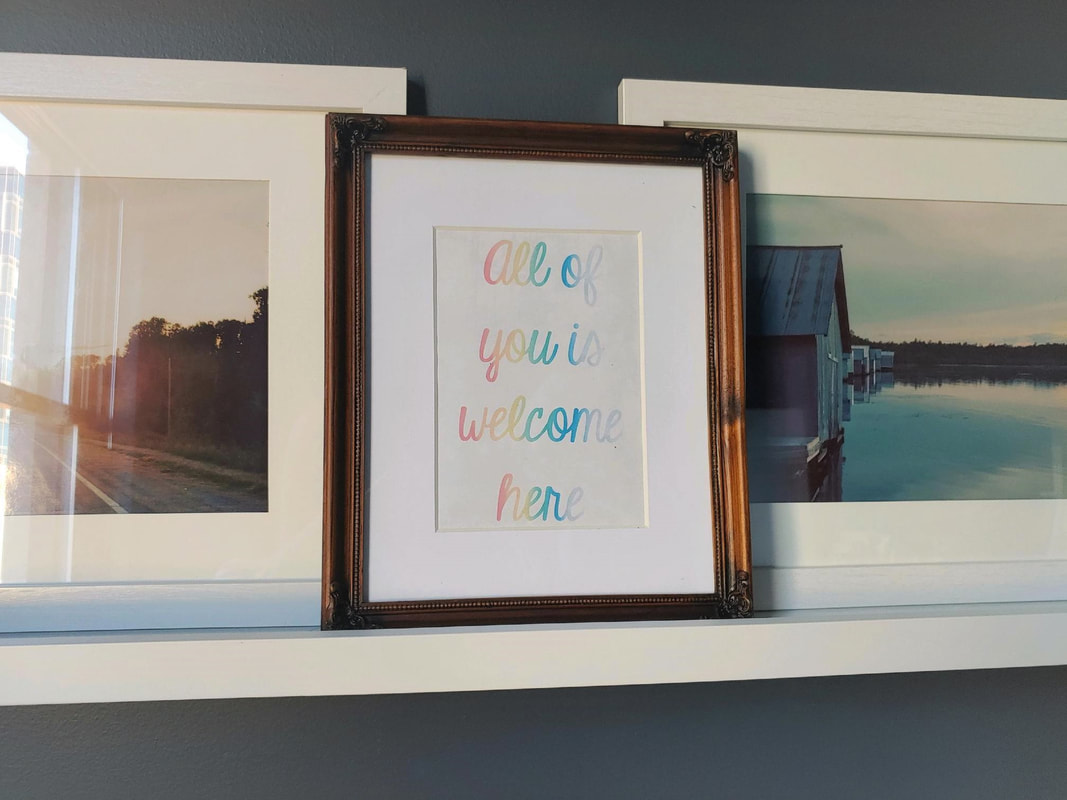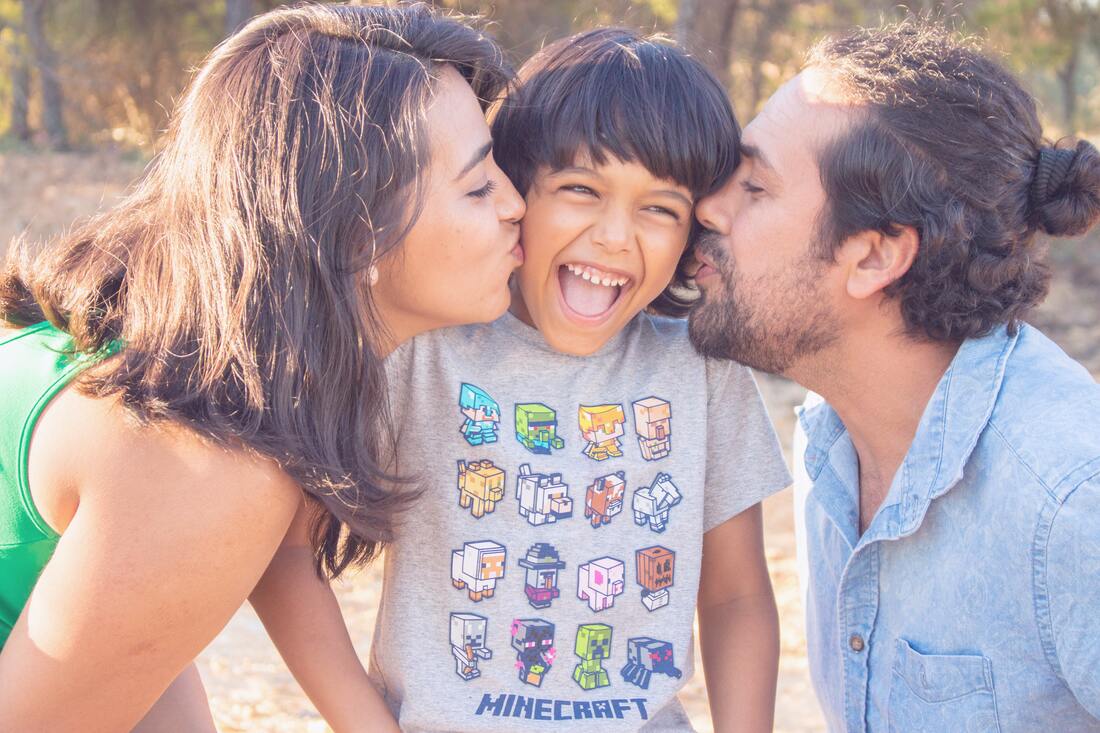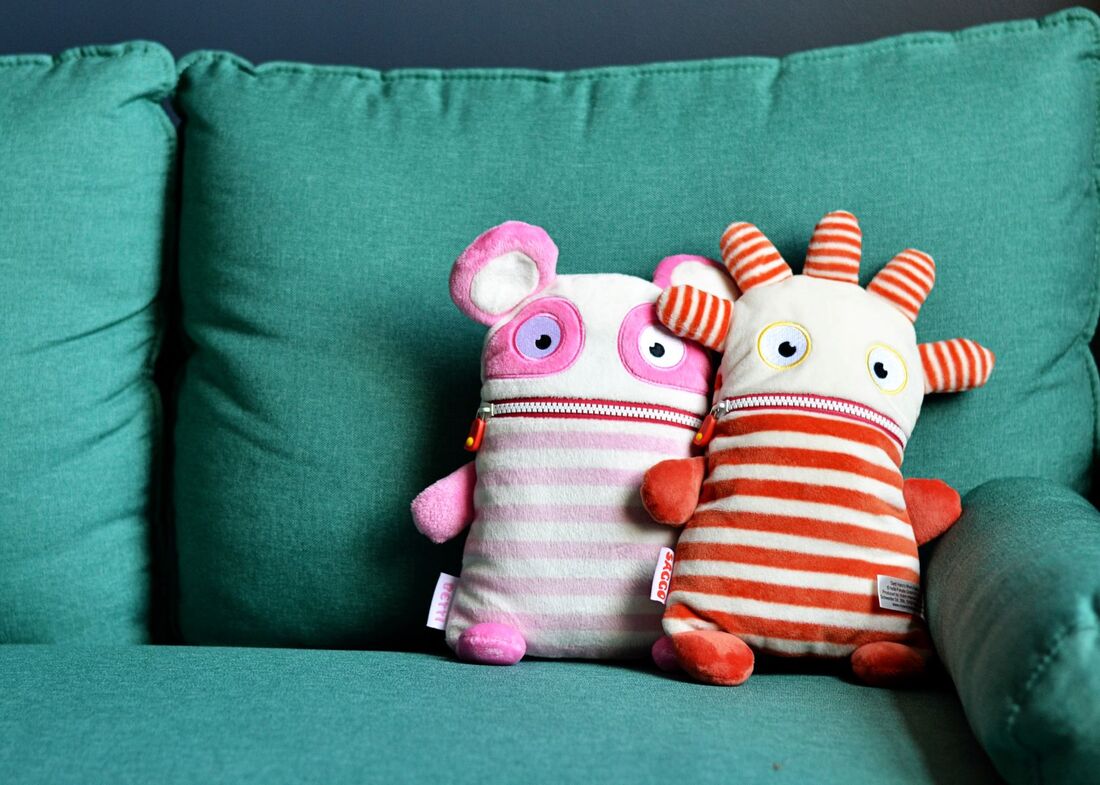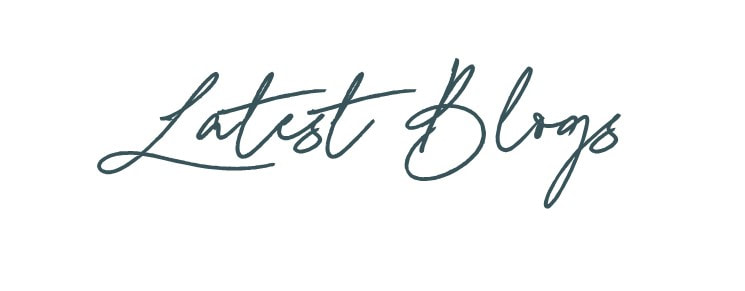|
In the playroom I have a sign that reads “All of you is welcome here”, which was inspired by this Podcast about Gender Identity and Sexual Orientation in the Playroom. *Side note – if you do not listen to the Lessons From The Playroom Podcast or had no idea it existed scoot on over to wherever you listen to podcasts or download iTunes! Seriously. It is SO worth it and makes for awesome in the car listening. Well, I guess anywhere listening - BUT I listen to most of my podcasts in the car. * Now, back to the sign! I was so inspired by this phrase and wanted to bring it into the place space as a way to signal my office a safe space for LGBTQAI+ clients and/or those that do not identify as cisgender. An article from the New York Times breaks down these categories and beautifully describes the + as “not just a mathematical symbol anymore, but a denotation of everything on the gender and sexuality spectrum that letters and words can’t yet describe”. Ahh YES to that! In the last 10 years there has been an explosion of different terms used to describe the complex layers of sexual orientation and gender identity. The LGBT Health and Development Program at Northwestern University has this awesome Prezi Gender Identity Map and I don’t know about you but I LOVE a good visual. A collaboration from The Safe Zone Project produced a *Comprehensive List of LGBTQ+ Vocabulary Words. That list – it has over 90 WORDS! For young people that I see that gender and sexuality is an important part of their story, I find myself asking questions, being respectful that the way one young person understands these concepts or heck even definition of terms can be slightly or completely different than the next, and googling. Like, a lot of googling. And, here’s the thing about the young people we work with, we may assume or the young person may have told us that they identify as cisgender and heterosexual, but they might not – and we may never know. Maybe there are some that don’t want us to know. They aren’t sure if we are safe, of what we will think. They might not be sure if what they say is confidential, even though I *hope* we all cover this clearly during the intake process. They may still be struggling with articulating it or admitting it to themselves. All of this is OK. It is our job to hold a safe space for our clients to express what they want and need to – even if sexual or gender identity isn’t part of what they share with us. This sign was my way of continuing to open up the conversation or play in a nonverbal and nonthreatening way. Not demanding or questioning, just being. Putting it out there so there might be less questioning or guessing if I am a safe person for them, or the therapy office is a safe space for who they are, all of them. SO why is this so important? Well…I may be preaching to the choir here, but the statistics with what these youth face are staggering. 7% of youth identified as LGBT and account for 40% of homeless youth. Let that sink in – 40%. AND LGBT youth contemplate suicide at three times the rate of heterosexual youth and are five times as likely as heterosexual youth to attempt suicide according to the Trevor Project. The Trevor Project has a TON of resources for LGBTQIA+ youth including a suicide and crisis hotline. Check it out here! And….if you didn’t know – now you know. And now that you know, you can evaluate! Is my office welcoming to everyone? How do I structure my intake process to make sure therapy is a safe space? Am I asking about preferred pronouns? Are there areas that I am rocking it? Are there areas I can improve? So, after all this I created a watercolor rainbow painting, scanned it in, and filled in the words of the quote with the watercolor. It now sits in my office everyday as a reminder…that all of you, and everyone that comes through my door, is welcome. Now, here’s the cool thing. As I look at it every day in my office it’s not JUST for LGBTQAI+ youth. It’s for everyone. The parent who feels like they aren’t enough, the child who is ashamed of her anger outburst, the young boy who feels like he is a failure because he didn’t score any goals, or all those parts of ourselves we feel shame about. The parts we feel nobody would accept if they really knew. Yes, all of those parts are welcome. Grab your free download HERE and drop a comment to share what you do to make your playroom more inclusive! Let’s all get INSPIRED! Let's Connect - click here to join my email list!
2 Comments
Imagine this…your boss has scheduled a meeting between you, herself, and her boss. They have vaguely told you it is about performance at work, but nothing else. Zip. Zilch. Nada. As you arrive at the meeting your boss stops you at the door and says they are going to meet first about you…without you. Why don’t you have a seat outside? My palms are just getting sweaty typing this. Can you picture this? What kind of thoughts would be running through your head? I guarantee not warm and fuzzy ones. You might be wondering how you messed up, racking your brain for what could be wrong, and likely having some symptoms of anxiety. Off the top of my head I’m thinking that racing heart, sweaty, can’t breathe feeling. The worst. I imagine this is what it feels like for a child who comes to a therapy office where the parent checks in alone (or guardian). It has certainly been my experience that when I am in the therapy office alone with a parent (which happens for a lot of different reasons) and the child is either tucked outside or in the waiting room, eventually comes the little knock on the door for ANYTHING. Like, sometimes just to say hi. Maybe it’s to ask what is for lunch. To tell a parent they got a text message. Or, sometimes from what my admin tells me, their little ear is pressed to the door straining to hear what we are saying. This is the reason that I check in about the week with parents and young people together. Now, I’m certainly not saying that I do this with 100% of my sessions or ALL of my clients, and we will definitely dive into that part. I am also not saying that you can’t create an atmosphere of a child that feels well regulated, safe, and secure during times when you check in with a parent alone. However, I want to make a case for a joint child/parent check in session as a respectful and helpful part of a child therapy practice. Checking in about the week as a team. My informed consent with families is loooong, and it is intentionally set up to create a neuroception of safety and consistency that both the child and parent can count on. In the initial session informed consent about the check in process usually sounds something like this: “Most sessions will look like us checking in together about your week, your goals, and anything else important that I need to know. I want to know what your strengths are and how you are succeeding during your week, because I know that you make so many great choices each and every day. I also want to get curious about the times you are struggling to see what could happen differently to support you in ways that feel better. Most of the time we will check in together with your parent, but sometimes parents need to do some hard work too or there might be some adult issues we need to discuss and I may want to check in with them alone. Sometimes, some kids get really nervous, angry, sad or anxious, or don’t like to check in together for whatever reason, and that is totally fine! Let me know and then I can make sure that your parent and I check in alone and you have something fun to do while you are waiting! The great news is, that you get to decide what works for you and what you are comfortable with.” Do you know how often kids are like “nah I’m good, check in with my parent without me?” – rarely ever. Even on the tough days. On these days when there have been some rocky stormy times, maybe even a tornado or two, I always re-check back with young people to make sure that they feel comfortable with participating. Most want to stay. Most often during these check ins we are rating two or three of the child’s goals. The parent and child rate separately and I make a HUGE deal by emphasizing that the ratings will not be the same, and likely won’t be until closer to the end of therapy. I use this as a compass to know if families are on the same page about what the level of distress is. This could sound like “on a scale of 1-10/10 how big was your worry? “, “how many friends did you play with on the playground this week?”, or “how many calm days did you have?”. MOST kids can answer these questions with practice, and if they can’t than you pivot. It could look like small, medium, or large ratings or a gesture of size with their hands. Some kids even get creative with sports metaphors for types of penalties. Sometimes we evaluate if it was a “game misconduct” or a minor infraction. It is so important to me to rate goals weekly so we can keep our treatment plan at the forefront AND so we can get curious about what factors are working for the child when they are doing well and what are the struggles when they are having difficult weeks. Now, some of the feedback I hear about this practice sounds like this: But isn’t it disrespectful of the child to talk about them? Won’t it be to distressing for them to hear about their behaviors? What about when you need to have a hard conversation about parenting skills? Or other “adults only” related things? These are all great questions and valid fears! Let’s tackle the first one – respect to the child! I think the big thing to get curious about with this, is not whether the child is present or not, but what is said while the child is present and how it is said. AND instead of talking about them we are talking with them. They are on the team. This does not OR should not look like both the parent and therapist staring the child down, shaking their fingers, and listing off all the ways the child misbehaved over the week. Definitely not therapeutic. The parent/child check in time is a great opportunity to model what it looks like to give positive feedback to a child, validate emotions, how to handle tough behaviors with a child, reframe, have empathy, and how to pull out their strengths each week. I am ALL ABOUT strengths. Even when the child and parent may be discussing a distressing tantrum or meltdown, I usually can pull out some strengths. Was the meltdown shorter than usual? Did the child apologize after? Did the child pick up the mess without asking? I emphasize all of these positive points even in the tough mucky stuff. Parents look at you like you are an alien at first, like – why are you pulling out strengths about this epic meltdown? Eventually, over time, it can produce this wonderful shift about the way that they see behaviors. It can also be an opportunity to gently reframe the way a parent talks about a child’s difficulty. And to be really honest, most families are on their best behaviors (not always) in the therapy space. A lot might get said to the child that is similar to less filtered or in the heat of the moment at home - that's life! This is a great learning opportunity of how it can be said a little differently, gentler, or with a smoother delivery. Other times, when a parent is rocking at describing a dynamic or behavior, or providing their child with validation or reinforcement, you can jump in on those positive moments too. Take time and space to highlight this wonderful moment in the relationship! Now, on to the second concern about how distressing this can be for the child. Again, the great news is they are in control. But, I am also a realist. The only person that has been with this child 24 hours per day, 7 days per week, is this child. Young people know how their week has been, they know when they are doing well and when they are struggling. By not having the child a part of the conversation, it gives them the message that they are too fragile and not strong enough to handle talking about the muck. If children become dysregulated it is an awesome opportunity to model parenting skills (or just good human interaction skills) of identifying feelings, validating the child’s experience, and co-regulating. Not to mention empowerment! You might say to the child “I am noticing your voice is getting a bit louder and you have an angry look on your face. What is going to work for you right now? Do you think you want to sit on or would you rather step up for a minute?” Those moments can be so powerful! When young people participate in these discussions, like are truly a collaborative and active participant, wonderful and magical things happen. The young person is the expert of his or her world, not myself or even their parent. It is during this time you can see the young person’s confidence grow, the shame lift, and when he or she becomes truly empowered. Now what about the last concern? Those truly adult level things? This might look like something with divorce or custody that the child should not know, or something with a court proceeding. This also could look like a parent who may need more space and support given the specific dynamics of the family. Sometimes there is something that comes up or is ongoing where a parent needs more support than a 5-15 minute check in. All of this (and more) definitely warrants a parent only session. For these, most often the parent comes without the child and the child is told that the therapist and parent have some hard work to do together- because kids aren’t the only ones who need to put in hard work – am I right? I will literally say that to them. It is one of the core things I do in my practice is model that adults make mistake and can grow too. I will also talk about how the young person gets to spend the MOST alone time focusing on what he or she might want to (especially with Child Centered Play Therapy) and sometimes a parent needs to focus on some things too. At the next session with the child I always ask the child if there are any questions for me or their parent. I will give the child a brief overview of what we talked about, and that usually suffices. The young person is usually just ready to play. Other times I deviate from checking in with the child and parent before the session when the check in has chronically creeped into the session time. For my time managements sake or at the request of the parent, we might pop it to the end of the session. This is usually a good indicator that a family may need more support. And again, the child is always in control of using their voice and saying that they want to wait outside. For other children this may be altered if through assessment and collaboration with the parent it feels as though the child cannot use their voice, are significantly distressed by the check ins, or some other factors that would deem it damaging. I think it is wise to not draw absolutes and flex when they need to. I find myself frequently saying and reflecting on that parents are the most important people in a child’s life and it can be tricky and complicated to balance both what the child will need as well as the family system as a whole. An intentional check in strategy can help move you towards this balance and structure. I am a strong believer that children can’t change in isolation (heck it is SO HARD for adults to change) and that therapy with children is so much more than just you and the child, it honors the family system. Overall, I am hoping this gets your gears turning of how you structure connecting with parents, sometimes considering a different perspective allows you to engage in a deeper evaluation of your practice. Sometimes it clarifies that what you are already doing makes the most sense for the way you work with children. I would love to hear how this looks in your practice and WHY! Drop a comment below if you have a check in strategy you love OR if you are struggling! Let's Connect - click here to join my email list!
If you know anything about me you know I love a good spreadsheet! I also love helping therapists achieve their professional goals as play therapists, child and adolescent therapists, and trauma therapists. AND if you know even more about me you will know I am always talking about EMDR. If you have never heard of the alphabet soup that is EMDR I am hoping to light a fire under you to get trained! EMDR stands for Eye Movement Desensitization and Reprocessing. It is a type of therapy that intentionally uses our bodies natural reprocessing mechanisms of REM (rapid eye movement) sleep and activation and integration of the right and left hemispheres of our brain to to help people heal from traumatic experiences and/or distressing life events. Some of the people I work with call it voodoo or magic because it seems a little strange AND it is so effective. In addition to witnessing the effectiveness in my clinical practice there is actually a gigantic body of research that has designated EMDR as an effective treatment for trauma. In the purest form we use bilateral (left and right) eye movements to help with this reprocessing but there are also many other forms that a therapist may use, especially in working with children. Paintbrushes, swords, or bongo drums anyone? And here is a little secret.... I am trained and certified in TF-CBT (Trauma Focused Cognitive Behavioral Therapy) and I rarely use it. It is because EMDR is that good and is able to produce faster results with less client distress for the children and adolescents that I work with. It is incredible to see someone open up a memory that is highly distressing and by the end of one session or a couple of sessions when revisiting that memory it is experienced without disturbance. I see this happen time and time again. It is wonderful. It is powerful. It is effective. If you want to learn more about EMDR, EMDRIA (EMDR International Association) is the place to start. Specifically this page will answer more questions about EMDR and has some great videos! If you are even more curious (which I hope you are) you can find training all over the country to become competent in the practice and delivery of EMDR. I am a little biased that I think the BEST training happens in Minnesota at Life Development Resources with Hector Matascastillo, MSW, LICSW, LSSW is EMDRIA Certified, Approved Consultant and an EMDRIA Approved Basic Trainer. I have the privileged of being a part of this training on day 5 where my training partner and I come in to do a full three hours on the application of EMDR with children and adolescents. I call it "Disney on Ice" (with strong Adaptive Information Processing (AIP) model as a backdrop) as we bring in all our toys, books, and games to showcase how to do this work with children and still hold fidelity to the standard protocol. When that day comes I am like a kid in a candy store and am giddy with excitement that I have a captive audience that I can share the importance of EMDR with children. For those of you who are trained *high five*! You also know that EMDR with children can be tricky and it something you need to seek out consultation for. EMDR consultation for the application of EMDR with children and adolescents is one of my areas of passion and I provide both in person and distance consultation. There is also a Facebook Group "Play Therapy and EMDR Conversations" that has a ton of EMDR consultants and EMDRIA has a special interest group specifically for child and adolescent therapists where you can connect with a consultant. If you are trained or thinking about getting trained in EMDR I encourage you to take a step further for certification. Why certification? Well...the certification process allows you to go above and beyond in the application and delivery of EMDR. The standard protocol is just the beginning. I'm not saying there is a protocol for EVERYTHING but dang sometimes it feels like it. There are protocols for attachment, addiction, pre-verbal trauma and SO MUCH MORE! Having consultation after your training and the additional continuing education you pursue will allow you to explore different protocols or areas of interest within the context of an ongoing consultation relationship. It helps you stay true to the fidelity of the model AND is a signal to other EMDR therapists that you have put in the work to be the best version of yourself in these EMDR sessions. It is also definitely something I look for when making a referral. EMDRIA has a directory of EMDR therapists that you can search by city or radius and it will designate if a therapist is certified or not. One thing I know is that if you are stepping up and going for certification you need some organization in your life. I created another spreadsheet for my consultants that I thought I would share with the greater EMDR community. It has a "cheat sheet" for criteria for certification, resources for the certification process and where to find CE opportunities and a place to track your client sessions, consultation hours, and continuing education. Get the guide HERE! Let's Connect - click here to join my email list!
These are my Big Feeling Eaters. Okay, so they are really called Worry Eaters, but I certainly DO NOT want to discriminate on the types of feelings they could eat. Angry, sad, or jealous feelings are just as important as worried feelings! These cute little monsters are anywhere from $24.00 on Amazon like these ones HERE and HERE! The awesome thing about these monsters is they come in such a BIG variety all with their own unique names like Flint, Polli, Enno, and Ping. I couldn't decide on just one so I bought three (sadly Schmidt did not make the photo shoot). This may be this pull inside me to allow children as much choice as possible, OR it could be indecisiveness. Either or, these three live out their lives in my playroom. If you are just starting Play Therapy or child and adolescent counseling with a tiny budget you can get these ZIPIT Monster Pencil Cases for around $8.00. Still too high? No worries I have your back – check out my Pinterest board for how to make your own with supplies you probably have on hand to live in your office. My favorite (even when I use my Big Feeling Eaters) is to make one out of tissue boxes for the young person I am working with to take home. And if I know one thing about therapists we go through a ton of tissue boxes. You can even recruit your office mates to save them for you! The other supply you need for this activity? Little colorful strips of paper to write the big feelings on. The young person gets to choose what pieces of paper best represents their feeling and trigger for the week giving them a sense of empowerment and control. Now that we know WHAT these guys are, let’s dive a little deeper into what you DO with them. I love to use these guys for compartmentalization or a container exercise, which can be incredibly helpful for those young people who ruminate on big feelings and let them take root and live in their brains and bodies. When this happens sometimes there is little ability, energy, or focus on anything but those darn big feelings. We see this all the time with the young people with whom we work. This might look like worries that prevent a child from going to bed on time, a child becoming so angry that it is not her turn for the iPad that she is unable to let these feelings go and carries them all the way to bed time (with a couple of blow ups on the way), or the young person who becomes so distressed when his basketball team loses that he can’t stop crying. If you are trained in EMDR this is a great activity to do before you enter the desensitization and reprocessing phases so clients have a container at home. Or for those incomplete sessions you can offer the Big Feeling Eater to contain the memory. It’s also an awesome Cognitive Behavioral Play Therapy technique. Here’s my scrip that I use to talk about this concept with young people: “These are my Big Feeling Eaters. They live here in my office and LOVE to help out young people. Their job is to eat big feelings like anger, sadness, jealousy, and worry. Their bellies can ONLY get full when they eat big feelings from children like you! They love to help out the young people I work with to make them feel better by eating all those big feelings that don’t feel good to them in the moment and that might make it hard to do the things they want! AND the young people I work with LOVE to help out the big feeling eaters by giving them some of their big feelings that aren’t working for them. Their bellies only feel full when they are eating big feelings. Anytime you come into this office and have a big feeling you want to get rid of you can choose to write it on that paper over there and feed it to the Big Feeling Eaters. The only rule is they have a super secret detection system, in if someone puts in a big feeling that isn’t safe then they will let me know. Otherwise the feelings will digest and make their bellies full!” I also intentionally leave the big feelings in their belly. WHAT? Doesn’t this violate confidentiality? Well…I want to normalize that others have big feelings too. Children are never left in my office without supervision, and rarely someone will try to reach it and look at the big feelings. When this happens I will say something like “OH NO! Those feelings are digesting – we can’t reach into their bellies and take them out. It would be like if someone reached in your belly and tried to take out your lunch – it would feel yucky!” I have never had a child not respect this boundary. The other piece to this is that I check the big feelings after the child leaves. If there was any identifying information (which there has not been yet) I would remove that big feeling. Most of the time it sounds something like “my math test”, “going to bed by myself”, "being sick" or just simply the feeling word. None of these big feelings could ever be identified and connected to the young person, so they stay and it can be powerful. A lot of the time young people will run and crunch the Big Feeling Eater’s belly and say “ohhh they’re still digesting”. OR other times they will make a comment such as “I bet I’m the only one who has fed them” only to discover that there are other feelings “digesting”. Recognizing that they are not the only child with big feelings, because sometimes it can seem that way, takes the shame out of the worries, tantrums, and tears. Some young people take it and run with it wanting to deposit feelings each time. Others know it is there for them when they need it. Overall it provides empowerment that we are in control over what we choose to occupy our minds and how we can regulate emotions with compartmentalization and container activities. If you had a Big Feeling Eater what feelings would you put in there this week? Frustration with paperwork? Stress with not enough time for emails or collateral contacts? Do you have other favorite compartmentalization activities you like to use with young people? Drop a comment below! Let's Connect - click here to join my email list! *This post contains affiliate links, so I may earn a small commission when you make a purchase through the links on this site. The best news? It doesn’t cost you a penny! Thanks for supporting my business by shopping my favorite playroom gear and accessories!
|
Hi, there!I'm Ann Meehan, an LPCC, Loading... Archives
July 2024
Categories
All
|
Privacy Policies | Terms of Use | Disclaimer
Contact
[email protected] | Copyright Meehan Mental Health Services 2022
Contact
[email protected] | Copyright Meehan Mental Health Services 2022








